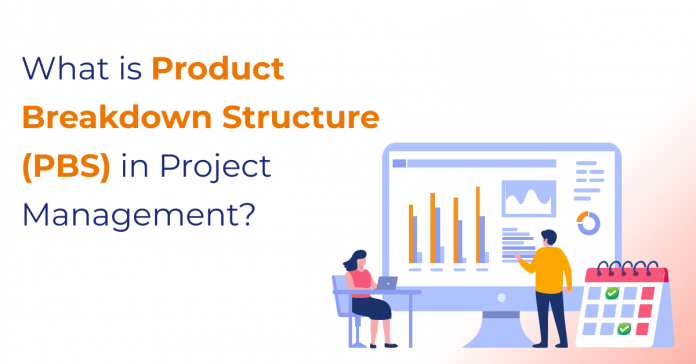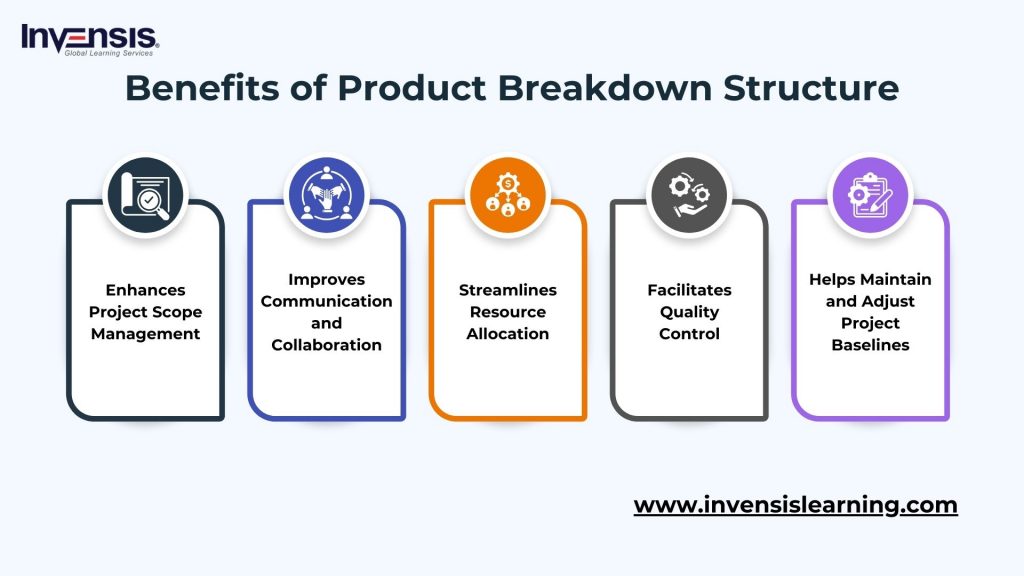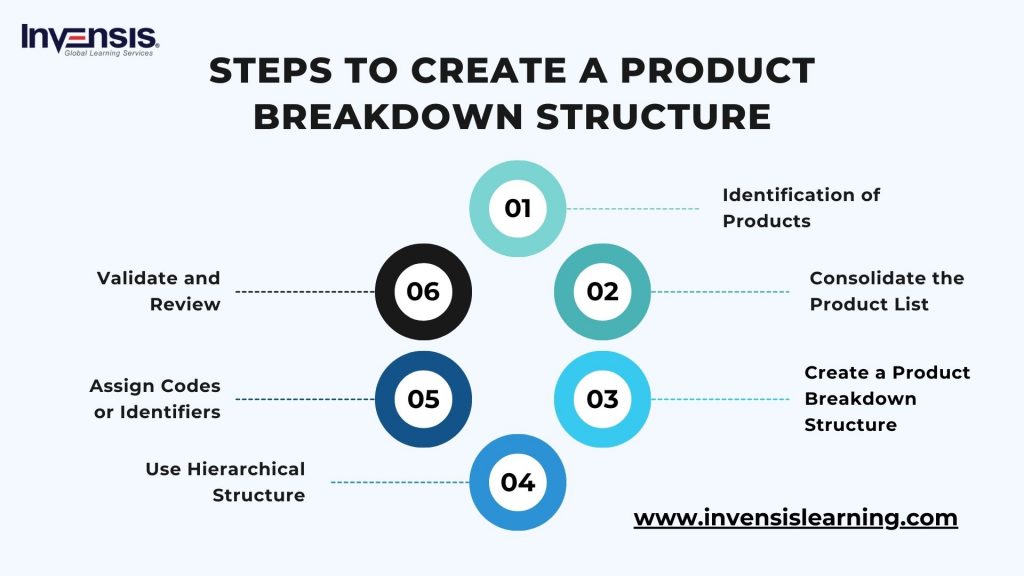
Have you ever felt like a project’s deliverables were a tangled mess? Imagine struggling to visualize the big picture, not sure how individual tasks contribute to the final product. You’re not alone. Managing complex projects requires a clear roadmap to keep everything on track. This is where the Product Breakdown Structure (PBS) comes in.
Think of Product Breakdown Structure as a project’s blueprint. It’s a hierarchical outline that breaks down the final deliverable into progressively smaller, more manageable components.
Like a map guides a traveler, a Product Breakdown Structure guides project managers and their teams by visualizing the project scope, improving communication and collaboration, ensuring deliverable quality, and facilitating resource allocation.
In this blog post, we will delve deep into the world of PBS, demystifying its essence, exploring its applications across various industries, and providing practical insights on creating and utilizing it effectively in your projects.
No matter if you’re a project management expert or just starting your journey, understanding the Product Breakdown Structure can be your secret weapon.
This blog will guide you to transform your approach from reactive shuffling to proactive control, ultimately leading to a successful project outcome.
Table of Contents
- What is a Product Breakdown Structure?
- Importance of Creating a Product Breakdown Structure
- Example of Product Breakdown Structure
- How to Create a Product Breakdown Structure?
- Product Breakdown Structure (PBS) vs. Work Breakdown Structures (WBS)
- Conclusion
What is a Product Breakdown Structure?
A Product Breakdown Structure (PBS) is a hierarchical decomposition of the total scope of work to be carried out by the project team to accomplish the project objectives and create the required deliverables.
It organizes and structures the project scope into smaller, more manageable components or levels, starting from the highest level, which represents the main project deliverable or end product, and breaking it down into increasingly detailed sub-components or work packages.
The Product Breakdown Structure provides a systematic and structured way to define, organize, and visualize the scope of a project, ensuring that all deliverables and tasks are clearly defined, understood, and allocated to the appropriate team members or departments.
It serves as a foundational tool in project management, helping project managers, team members, and stakeholders to gain a comprehensive understanding of the project scope, identify dependencies between different deliverables and tasks, establish clear accountability and responsibility for each work package, and effectively plan, monitor, and control project activities and progress.
Importance of Creating a Product Breakdown Structure
A Product Breakdown Structure is an investment in project clarity, efficiency, and, ultimately, success. By taking the time to create a well-defined PBS, project managers, and teams can ensure everyone is on the same page, resources are used effectively, and the project is delivered on time, within budget, and to a high standard.
Creating a Product Breakdown Structure offers several advantages that can significantly enhance the effectiveness and success of a project.
-
Enhances Project Scope Management
A PBS acts as a visual roadmap, providing a clear picture of the entire project scope management. It ensures everyone involved identifies and understands all project deliverables, minimizing the risk of missing crucial elements. This clarity helps keep projects on track and avoids scope creep later on.
-
Improves Communication and Collaboration
By outlining the project’s components and how they interrelate, a PBS fosters a shared understanding among team members. This transparency promotes better communication and collaboration as everyone is aware of their role and how their work fits into the bigger picture.
-
Streamlines Resource Allocation
A well-defined Product Breakdown Structure allows project managers to allocate resources effectively, such as time, budget, and personnel. By understanding the complexity of each deliverable, resources can be targeted efficiently, ensuring the project stays within budget and timeline constraints.
-
Facilitates Quality Control
The breakdown structure allows for the identification of quality control measures at each level. This ensures that individual components meet quality standards, ultimately leading to a higher-quality final product.
-
Helps Maintain and Adjust Project Baselines
A PBS serves as a valuable reference point throughout the project lifecycle. It allows for comparisons between planned deliverables and actual progress, making it easier to identify deviations and course-correct as needed.
How to Create a Product Breakdown Structure?
Creating a Product Breakdown Structure (PBS) involves a systematic and structured approach to decomposing the project scope into smaller, more manageable components or work packages.
Here’s a step-by-step guide on how to create a Product Breakdown Structure:
-
Identification of Products
The first step in creating a PBS is the identification of products or deliverables that need to be produced to achieve the project objectives. Begin by listing down all the major products, sub-products, components, or deliverables that are required to complete the project.
These could range from tangible items, such as products or prototypes, to intangible items, such as documents, reports, or software modules. Clearly defining and identifying these products will lay the foundation for creating a structured and organized PBS.
-
Consolidate the Product List
Once you have identified the products or deliverables, consolidate the list to eliminate duplicates, overlaps, or redundancies. Group similar or related products together to create categories or clusters to serve as the basis for higher-level nodes in the PBS.
This consolidation process helps streamline the list and ensures that each product is represented uniquely and comprehensively in the PBS, avoiding confusion and ambiguity.
-
Create a Product Breakdown Structure
With the consolidated product list, start creating the product breakdown structure by organizing the products into a hierarchical and structured framework.
Begin with the main project objective or end product at the top level, followed by major deliverables at the second level, and further break down each major deliverable into smaller, more detailed sub-deliverables or work packages at the subsequent levels.
This systematic decomposition process forms the core of the PBS, providing a clear and visual representation of the project scope and structure.
-
Use Hierarchical Structure
Organize the products, major deliverables, and sub-deliverables in a hierarchical structure within the Product Breakdown Structure. Ensure that each level is logically connected and builds upon the previous level, creating a coherent and cohesive framework.
This hierarchical arrangement helps in defining the relationships, dependencies, and interconnections between different products and components, facilitating better understanding, planning, and management of the project scope, tasks, and activities.
-
Assign Codes or Identifiers
Assign unique codes, identifiers, or numbers to each product, major deliverable, and sub-deliverable within the PBS. This coding system provides a systematic way to track, reference, and manage the components or work packages, especially in larger or more complex projects.
It enhances the organization, accessibility, and control of the PBS, allowing project managers and team members to easily navigate, identify, and manage the various elements of the project scope.
-
Validate and Review
Once the initial PBS is created, validate and review it with key stakeholders, project team members, or subject matter experts to ensure completeness, accuracy, and alignment with the project objectives, requirements, and constraints.
Gather feedback, insights, and recommendations from the review process and make necessary adjustments or refinements to the structure.
This validation and review step ensures that the PBS is powerful, relevant, and aligned with the project’s evolving landscape and objectives, setting the stage for successful project execution and delivery.
Example of Product Breakdown Structure
Imagine you’re building a mobile app for grocery shopping. Here’s how a Product Breakdown Structure might look for this project:
Project Objective: Mobile Grocery Shopping App
Level 1 Breakdown:
- User Interface (UI) components
- Login screen
- Product browsing interface
- Shopping cart interface
- Checkout interface
- Back-end functionality
- User authentication
- Product database
- Shopping cart management
- Payment processing system
- Order management system (Tracks orders placed)
Level 2 Breakdown:
- Login screen
- Username input field
- Password input field
- Login button
- Forgot password link
Key Points:
- The structure breaks down the final deliverable (mobile app) into major components (UI and Back-End)
- Each component is divided into sub-components (e.g., Login Screen under UI)
- The level of detail can be increased as needed (Level 2 Breakdown for Login Screen)
- It ensures all aspects of the app are captured (user interface, functionalities, etc.)
Benefits of this Example:
- This structure clarifies the different elements needed to develop the app
- It helps estimate resources and timelines for each component
- It promotes communication and collaboration within the development team
- It allows for easier identification and management of potential risks
Using the structure, project managers and teams gain a clear understanding of the project scope and can effectively plan, execute, and deliver the final product.
Product Breakdown Structure (PBS) vs. Work Breakdown Structures (WBS)
Product Breakdown Structure (PBS) and Work Breakdown Structure (WBS) are valuable tools in project management, but they serve different purposes and focus on different aspects of a project. Here’s a comparison to help differentiate between the two:
| Aspect | Product Breakdown Structure (PBS) | Work Breakdown Structure (WBS) |
| Focus | Emphasizes project deliverables or end products | Highlights tasks, activities, or actions required to complete the deliverables |
| Purpose | Provides a structured and visual representation of what needs to be produced or delivered by the project | Provides a structured and detailed breakdown of the work that needs to be done to complete the project |
| Hierarchy | Organized hierarchically, starting with the main project objective or end product, followed by major deliverables, sub-deliverables, and work packages | Also organized hierarchically, starting with the project objective or end product, followed by major tasks or phases, sub-tasks, and work packages |
| Usage | Used during planning and initiation phases to define, organize, and clarify project scope and deliverables | Used throughout the execution and monitoring phases to plan, schedule, assign, and track tasks and activities |
Conclusion
In project management, a Product Breakdown Structure (PBS) serves as an indispensable tool for navigating complex and large-scale projects. It provides project managers with a holistic view of the project scope, allowing them to identify and prioritize areas that require more detailed attention.
This structured approach not only enhances project planning and execution but also ensures transparency and visibility across all project components.
Ready to unlock the power of PBS? Invensis Learning’s Project Management Certification Courses offer a comprehensive curriculum designed to equip you with the knowledge and tools to excel in this critical project management skill.
Their courses will not only deepen your understanding of breakdown structures but also provide you with the expertise to develop and monitor projects effectively.
















